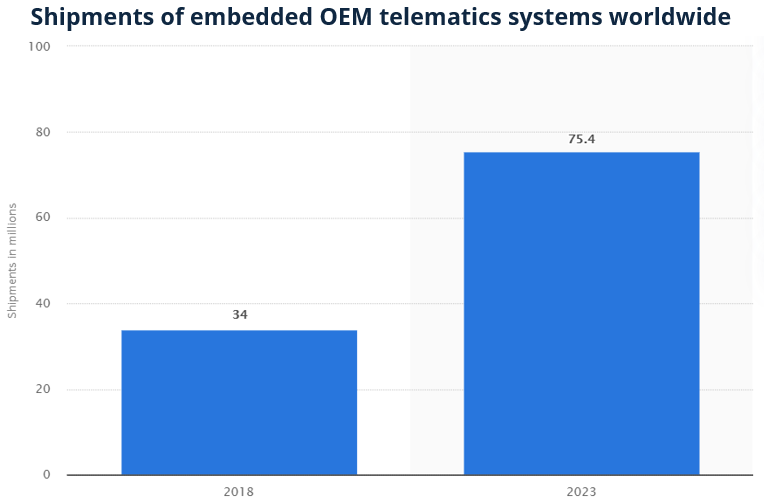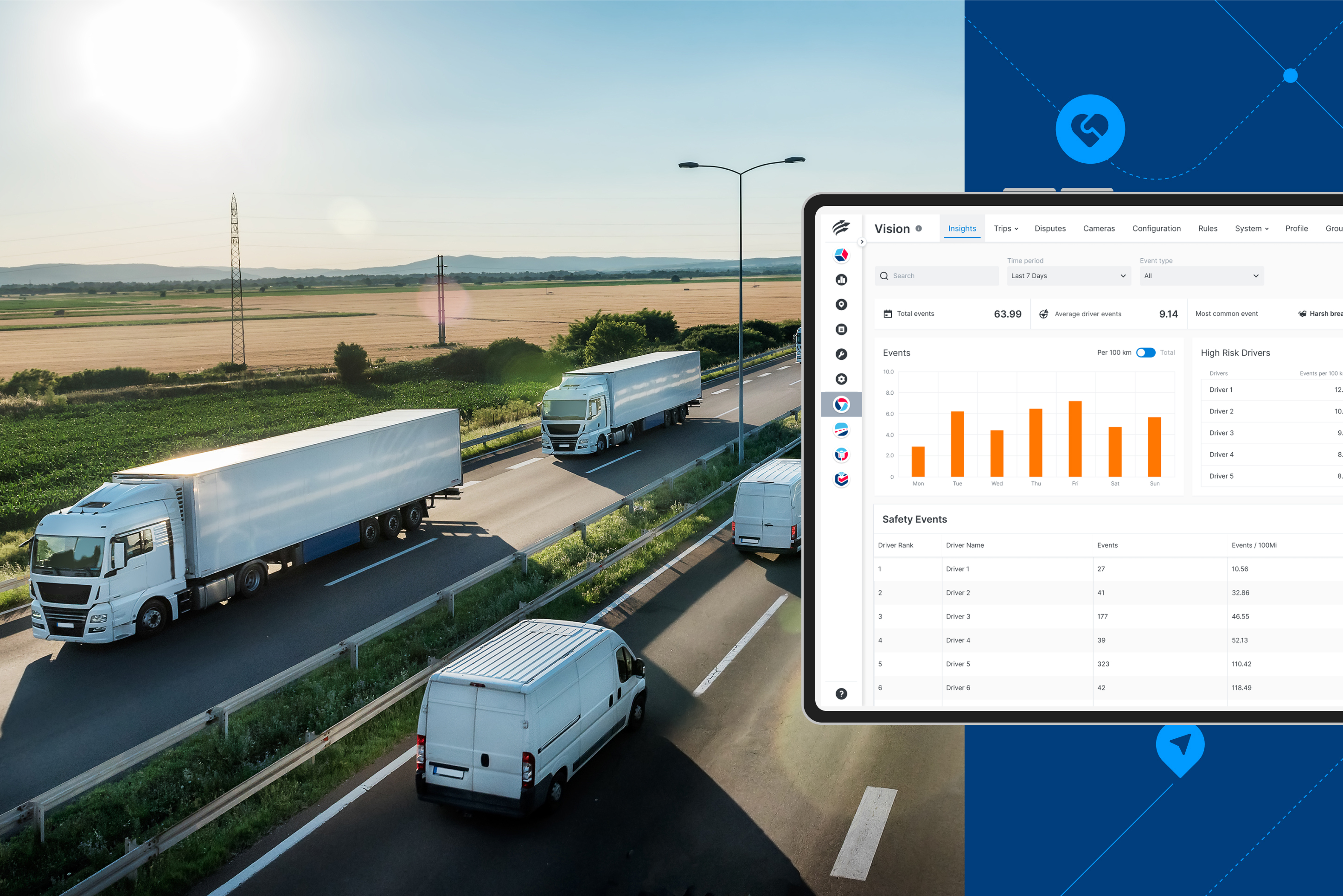When it comes to fleet management, it’s a well-known fact that telematics offers a huge advantage for fleet effectiveness and productivity – from improving fuel efficiency to increasing safety and vehicle maintenance.
So, it’s no surprise that most major automotive companies – also called original equipment manufacturers (OEMs) – produce vehicles with pre-installed hardware that’s compatible with fleet telematics. This enables their vehicles to integrate with an aftermarket software provider upon purchase – allowing users to gain the benefits of fleet telematics immediately.

With an expected compound annual growth rate of 14.2 percent between 2018 and 2023, the popularity of OEM telematics continues to rise (Image Source).
Alternatively, if you buy a vehicle without factory-embedded telematics hardware, you can use a third-party provider (like Powerfleet (formerly Fleet Complete)) to install the hardware after purchase.
With two options for fitting your vehicle with fleet telematics hardware, the question is: which one is the right choice for your business?
When deciding between OEM hardware or a third-party provider, there are several factors to consider to ensure you’re making the decision that makes the most sense for your company. This article will help differentiate your options when purchasing vehicles and outline the factors to consider that will help you make an informed final choice.
What is OEM Telematics?
Before deciding on a hardware option for your business, let’s dive deeper into what OEM-fitted telematics hardware is and how it works.
As mentioned above, OEM refers to vehicle manufacturers – many of which now produce vehicles that are pre-installed with hardware that’s compatible with fleet telematics upon purchase. This allows the vehicle to immediately integrate with a third-party fleet management software provider without the need for additional hardware installation.
One of the biggest advantages of opting for the OEM hardware route is that you can instantly use fleet management telematics upon obtaining the new vehicles. The benefits of this include:
- Easy telematics implementation for a shorter procurement process
- Saving time on compatibility testing
- The ability to plan your new fleet acquisition with telematics in mind
With factory-installed hardware, you can immediately subscribe to a telematics service from an aftermarket provider and start collecting and interpreting valuable data from your fleet vehicles without delay.
OEM vs. Third-Party Hardware – Which Option is Best for Your Business?
While there can be many benefits to choosing vehicles with built-in fleet telematics hardware, it isn’t necessarily the best option for all businesses – as opting for a third-party provider can come with its upside, too.
It’s worth considering the following factors regarding the two telematics options when purchasing new fleet vehicles to ensure you select the one that matches your business needs best.
1. Types of Vehicles in Your Fleet
When purchasing vehicles, it’s usually the newer and most up-to-date models that come equipped with pre-installed telematics hardware – as this form of software integration is a relatively recent industry trend.
So, an important factor in the OEM vs. third-party hardware debate is what type of vehicles you are looking to buy.
For fleets that aren’t interested in getting the latest updated vehicles, choosing OEM-embedded tech may not be the best option. Opting for a third-party hardware provider allows you to purchase any vehicle – regardless of make or model – and install hardware into it that connects to your fleet management software, removing the limitation to only buy certain vehicle types.
2. Installation Downtime
One of the main benefits of the OEM telematics route is the lack of vehicle downtime caused by installations. Since the hardware comes pre-installed upon purchasing, OEM-embedded tech allows you to immediately take to the road and reap the benefits of telematics.
However, going the route of a third-party hardware provider means there will be time needed for your vehicles to be set aside to complete the installation.
This is why it’s important to access your business’s activity. If you’re constantly on the go and rely on your vehicles to be road-ready – such as a company in the delivery or transportation industries – then installation downtime should be accounted for when choosing a third-party provider.
If it’s essential that your vehicles remain on the road with as few interruptions as possible, OEM-embedded hardware can offer a handy solution and could be the best option to take.
3. Reporting Frequency
An important aspect of hardware that’s crucial to consider is how fast the device can upload data and report it back to you. This is called reporting frequency, and it can differ between OEM-embedded and third-party hardware.
With third-party providers, the reporting frequency of the device can be configured upon installation, allowing it to be set as high as a couple of seconds – providing true real-time fleet data availability. Whereas for OEM hardware, the default reporting frequency cannot be changed and is commonly around 30 seconds.
For many businesses, this isn’t much of a deterrent from choosing OEM hardware, as a 30-second reporting frequency is still quick enough to meet their business needs. However, if your fleet operates in an industry where every second counts – such as first responders – this is a make-or-break feature that OEM hardware could lack, making third-party hardware with speedier reporting the better choice.
4. Compatible Add-Ons
When it comes to fleet telematics, many businesses rely on more information than just GPS location to operate effectively. This can include:
- External sensors that can track temperature, pressure, or power take-off switch.
- Electronic logging devices (ELD) to track Hours of Service (HOS)
- Driver ID systems to monitor who is operating a vehicle
- And more
But, with OEM-equipped telematics, you can only rely on the information the pre-installed hardware can provide – and nothing extra.
Third-party installers offer the ability to include add-ons – such as ELD or external sensors – upon installation, ensuring your hardware is capable of more than just the standard reporting, like location tracking and driver behaviour. If your business counts on these added insights to operate effectively, third-party providers may have the edge over OEMs.
We’re Here to Help
While OEM hardware can be beneficial and handy for many businesses, it’s important to consider the factors outlined in this article when deciding on a telematics solution for your fleet.
No matter which route you choose, Powerfleet (formerly Fleet Complete) is ready to help. With the option to install our hardware after purchasing a vehicle or buy from one of our many OEM partners, we support both solutions.
Powerfleet’s (formerly Fleet Complete) OEM partners include:
- Ford
- General Motors
- Toyota
- Mitsubishi
Powerfleet’s (formerly Fleet Complete) experts are on hand to help your fleet make use of telematics – whether that involves using OEM-embedded or aftermarket hardware. Get started today by trying out our Powerfleet (formerly Fleet Complete) demo.






































































